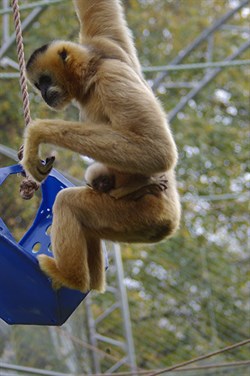White-cheeked gibbon born at Stone Zoo
Friday November 7, 2014
 The staff at Stone Zoo is pleased to announce the birth of a white-cheeked gibbon.
The staff at Stone Zoo is pleased to announce the birth of a white-cheeked gibbon.
The baby, whose sex is not yet known, was born October 16 to Iggy, age 14, and Kien Nhan, age 13. Along with its parents and older sibling Paddy, age 3, the baby made its exhibit debut on November 5. It must be at least 60 degrees and not raining for the baby gibbon to be on exhibit.
“Since the white-cheeked gibbon exhibit opened at Stone Zoo in 2009, it has been one of the most popular spots within the Zoo. Guests take great delight in watching the gibbons demonstrate their incredible agility as they swing and play throughout this space,” said John Linehan, Zoo New England President and CEO. “We are thrilled to share the news of this exciting birth of a critically endangered species, and it will be very special for our guests to watch this baby grow up as well as observe the family dynamics.”
White-cheeked gibbons display a rather extreme form of sexual dimorphism (physical differences between the genders) – the males are nearly all black while the females are nearly all cream colored. White-cheeked gibbons are born with a light-colored coat that resembles their mother’s coloration, which helps to camouflage them. IUCN categorizes this species as critically endangered as the population has declined by at least 80 percent in the past  45 years due to hunting and habitat loss. Zoo New England participates in the White-cheeked Gibbon Species Survival Plan (SSP), which is a cooperative, inter-zoo program coordinated nationally through the Association of Zoos and Aquariums (AZA). SSPs are designed to maintain genetically diverse and demographically stable captive populations of species. This birth is the result of a recommended breeding between Iggy and Kien.
45 years due to hunting and habitat loss. Zoo New England participates in the White-cheeked Gibbon Species Survival Plan (SSP), which is a cooperative, inter-zoo program coordinated nationally through the Association of Zoos and Aquariums (AZA). SSPs are designed to maintain genetically diverse and demographically stable captive populations of species. This birth is the result of a recommended breeding between Iggy and Kien.
Gibbons are apes, not monkeys, and are social animals, living in small, stable family groups consisting of a mated pair and their juvenile offspring. These endangered animals, which are native to Southeast Asia, spend most of their lives in trees and move by swinging between branches and vines using their arms (this is called brachiating). They are incredibly agile and can leap across gaps in the tree canopy up to 30 feet.
Learn more about gibbons in Stone Zoo's Animals section.
Photos: Zoo New England/Dayle Sullivan Taylor

